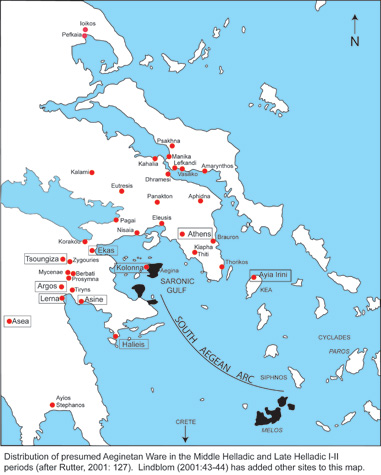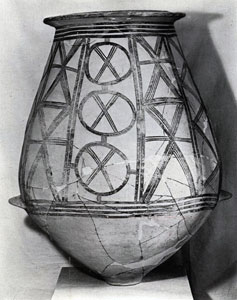

HOME | INTRODUCTION | J. BROPHY | C. SHRINER | GEOCHEMICAL DATABASE | SEARCHABLE DATABASE
AEGINA ISLAND HISTORY | BIBLIOGRAPHY | FUNDING | FIELD WORK | IMAGE DATABASE
![]()
A Specific Use of the Database: Distribution of Aeginetan Ware
The SAVA database is presently being developed in order to quantitatively provenance the distribution of Aeginetan Ware, an important Greek Bronze Age (3000-1100 BC) ceramic, presumably produced on Aegina Island, Greece. We first fully characterize the sources and geochemical characteristics of true Aeginetan Ware and then compare these results with sample sets of presumed Aeginetan Ware excavated throughout the Aegean and mainland Greece.
Sample sets to date include many of the well-known sites of the Argolid, such as Argos, Lerna, Tsoungiza, and Asine. In addition we have sample sets from the prehistoric portions of the Athens Acropolis; Asea, a sanctuary site in Arcadia; Halieis, a Neolithic site in the Southern Argolid, and Kolonna, the large production center on Aegina Island. Contributing archaeologists include a range of international collaborators, along with American colleagues: Dr. Jeannette Forsén, Gothenburg University, Sweden; Drs. Gullög Nordquist and Christina Risberg, Uppsala University, Sweden; Drs. Florens Felten and Lydia Berger, University of Salzburg, Austria; Dr. John Camp, Director of the Athens Agora Excavations (ASCSA); Dr. Jeremy Rutter, Dartmouth College; Dr. James Wright, Bryn Mawr College; Dr. John Papadopoulos, University of California; Dr. Susan Rotroff, Washington University; and Dr. Daniel Pullen, Florida State University.
History of Aeginetan Ware Distribution Studies
Zerner's study (1978) of the pottery from the Early Helladic (EH) III /Middle Helladic (MH) transition (2050-2000 BC) and the MH (2000-1680 BC) period at Lerna provided a relative chronology for the MH period in mainland Greece. Zerner's main classification criterion for MH pottery from Lerna was fabric type. Early in her investigations she noted visually distinctive clay types and mineral inclusions in the pottery (1986). It was during her research at Lerna that she began the process of provenancing a distinctive fabric which contained visible inclusions of biotite. Hence, the fabric group was classified as the “Gold Mica Fabric”.
The distinctive “gold mica” inclusions in the fabric group encouraged Zerner to supplement her stylistic classification with petrographic analysis of decorated classes. As described in Zerner (1986), Betancourt and Myer characterized representative samples from three common classes of the fabric group (Matt painted and Plain, Red/Black Slipped and Burnished, and Coarse Plain). Their petrographic analysis revealed that the untempered fabric is made from a crystal vitric ash that contains hornblende, oscillatory zoned plagioclase feldspar, pyroxene and carbonate fragments (probably calcite or dolomite) in a glassy mesostasis.
As a result of the petrographic analysis, Zerner was able to extend the identification of this distinctive “Gold Mica” fabric group to three or four unpainted classes, including cooking pottery. In addition, the petrographers compared the Lerna samples of the Gold Mica Fabric group with sherd samples from Kolonna, Aegina. The fabrics were similar. Zerner had already discerned that the closest stylistic parallels for most of the vessels in this fabric group came from the site of Kolonna. On the basis of her stylistic analysis and the petrographic characterization, Zerner proposed Aegina as the source of this pottery and Kolonna as a probable center of production (1986, 1993). Zerner's “type sample” for Aeginetan Ware, which was actually sampled at Lerna, consisted of eight sherds that defined stylistically and petrographically the characteristics of Aeginetan Ware.
four unpainted classes, including cooking pottery. In addition, the petrographers compared the Lerna samples of the Gold Mica Fabric group with sherd samples from Kolonna, Aegina. The fabrics were similar. Zerner had already discerned that the closest stylistic parallels for most of the vessels in this fabric group came from the site of Kolonna. On the basis of her stylistic analysis and the petrographic characterization, Zerner proposed Aegina as the source of this pottery and Kolonna as a probable center of production (1986, 1993). Zerner's “type sample” for Aeginetan Ware, which was actually sampled at Lerna, consisted of eight sherds that defined stylistically and petrographically the characteristics of Aeginetan Ware.
Based on these stylistic attributes and limited petrographic characterization, Zerner (1993) and other archaeologists (Rutter, 2001; Lindblom, 2001) compiled a distribution map for Aeginetan Ware (See map). Zerner (1993) suggested that throughout the Middle Bronze Age, Aeginetan pottery was distributed in large quantities and over much of the Greek mainland and islands: Arcadia: Asea; Argolid: Argos, Asine, Lerna, Mycenae, Tiryns, Zygouries; Attica and the Saronic Gulf; Boeotia; Euboea; and the Cycladic islands: Kea (Ayia Irini) and Thera (Akrotiri). At the end of the MH, Aeginetan imports began to appear in other areas: Laconia , Ayios Stephanos and Aliveri, and in the Corinthia, at Tsoungiza. Aegina was presumed to be the single source for all of these similar sherds. This distribution has been explained in terms of a widespread Aeginetan ceramic trade network and has been used as evidence for the economic and perhaps political hegemony of Aegina during the Middle Helladic period of the Aegean Bronze Age.
Findings: Nature of Aeginetan Ware Distribution: "Local Cultural Change Model" PowerPoint Slides
The presumed distribution network for Aeginetan Ware is based on the assumption that certain ceramics throughout the Aegean have similar fabric and stylistic characteristics. Our approach has necessitated the development of a new quantitative geochemical definition for Aeginetan Ware. Based on that geochemical definition, it does not appear that all of the sherds in the present distribution map are from Aegina itself. The fact that all of these samples are not local to Aegina casts the notion of the distribution network into doubt. It appears that further study into the true nature of Aeginetan Ware distribution can only move forward with the application of the SAVA database and a new geochemical definition for the Ware.
![]()
Last Updated:
July 1, 2014
Copyright, Indiana University 2009